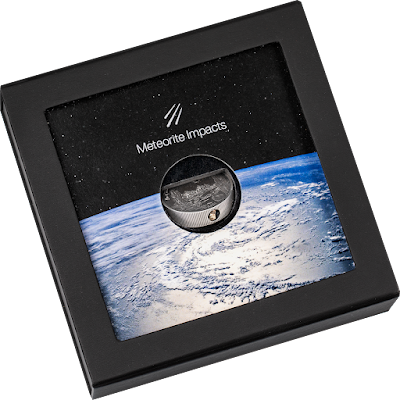1988) La Ciénega , Sonora, Mexico , Cook Islands: 17th issue in the "Meteor Impact Coin Series": A $5 (Five Dollars) Silver Coin featuring a real piece of the Meteorite embedded in the Coin: Project coordinated by Coin Invest Trust (CIT): Minted by B.H. Mayer's Kunstprageanstalt at their facilities in Munich: Year of Coin issue: 2021:
This is the 17th edition of the Meteorite Impacts Coin Series (a award-winning coin series) and it is dedicated to the Ciénega Meteorite discovered by Hugo Lino in 2014, found in La Cienega, Sonora Mexico.
The Discovery:
It was a sunny day when geologist Hugo Lino was prospecting for gold near the abandoned mining community of La Ciénega in Sonora, Mexico on January 30.01.2014. He could not believe his eyes when he found a 6.1 kg (6143 grams) fusion crusted meteorite. The stone was subsequently purchased by Michael Farmer.
The meteorite stone displayed the following physical characteristics: It was a relatively fresh fusion crusted rounded stone with a few broad regmaglypts, sawn surface, largely light colored with scattered rust staining around metal grains. The metal was evenly distributed with grains to 2 mm. Chondrules difficult to recognize, with one to 4 mm.
Petrography: The stone was largely recrystallized with difficult-to-recognize chondrules, including BO, PO, and RP. Many olivine grains with planar fractures. Plagioclase were abundant and often less than 100 μm. Chromite irregularly shaped, to 600 μm. Kamacite irregularly shaped with weakly developed Neumann bands; some grains polycrystalline.
Metal grains of tetrataenite rims and cores of dark-etching plessite or acicular kamacite common. Troilite largely single crystal and lacking shock features. Sparse metal pockets around troilite and metal. Native Cu was rare to 20 microns. Weathering was low and locally present around some kamacite grains. Many of the metal-troilite grains show complex finely intergrown textures of the two.
Classification: L6, W1, S3; Specimens: 164 g and one thin section at ASU.
We did pick up a few Meteorite stones/fragments, but did not bring them with us, leaving them in the places where we found them. Little did I realise that pieces of meteorites similar to the one that we left behind, would one day figure on Platinum-Silver coins issued by Coin Invest Trust (the Estacado meteorit strike) and the Royal Astronomical Society of Canada (RASC - celebrating its 150th year of establishment). The Links to my posts on this blog on our visit to the Lonar Crater Lake and my post on the RASC milestone are given below:
3) A road trip to Lonar and Aurangabad (Revisited)
1) The Evolution of Mexican Coinage
26) A new 100 Boliviano Banknote from Bolivia: issued by the "Banco Centrale de Bolivia" (Central Bank of Bolivia) on 15.01.2019 under its new 2018 Banknote Series
27) Central Bank of Uruguay ("Banco Centrale del Uruguay"): 50th Anniversary (Golden Jubilee) - 1967-2017 - celebrated with the issue of a 50 Peso Commemorative Banknote on 14.09.2018
29) Did You Know Series (44): Decoding the Aztec Calendar Sone (or the Sun Stone of Axyacatl)
Links to Posts on Curacao on this Blog:
18) Sea Motifs, Bahamas: Gold Bullion Coins in the denominations of 100 Dollars (depicting a Blue Marlin) and 250 Dollars (depicting a Conch Shell): Coins issue date: 03.12.2019
19) A new Generation $100 Polymer Banknote, Trinidad and Tobago with enhanced security features to "raise the bar" for counterfeiters & unscrupulous elements: Banknote circulation date: 09.12.2019:
20) Festival di Tumba (Carnival of Curacao), Curacao: "50th Edition of the Curacao Carnival/Festival" held from 27-31.01.2020: A set of six Commemorative Postage Stamps brought out by Cpost (Curacao Post) on 20.02.2020
21) New Polymer Banknotes, Trinidad and Tobago: The entire series will consist of $100, $50, $20, $10, $5 and $1 denominations: $100 has already been issued on 09.12.2019
23) "Caribbean Sea-Horse", Barbados: $10 (Ten Dollars) 1.0 Oz. Gold Bullion Coins & $1 (One Dollar) 1.0 Oz. Silver Bullion Coins minted by the Scottsdale Mint; Year of issue: 2020
24) Cayman Islands, A British Overseas Territory (BOT): A set of identically numbered Banknotes of the presently circulating Banknotes from the "D" Series of Banknotes









No comments:
Post a Comment